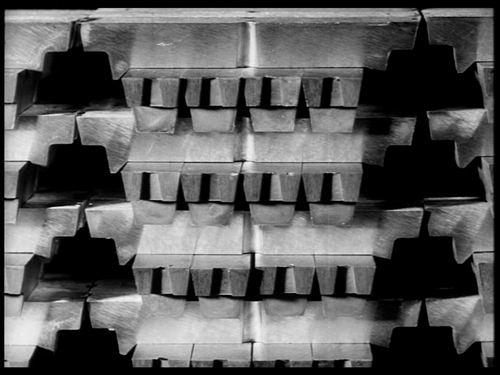‘To the Wolf’ will be screening together with ‘Aluminum of Greece’ (made sometime in the 60’s) by Roussos Koundouros on the 8th of November at FILMMAKER FESTIVAL MILANO. http://www.filmmakerfest.com/

(text by programmer Vassilis Bourikas)
Aluminum of Greece is a rigorous and precise film record of technological advancement in 1960’s Greece; both the subject matter and its filmic treatment radiate hope for the country. Yet you could get a sense of despair when you view this film today, specially if you are from down there.Sto Lyko was made circa 50 years later and appears as the total opposite. It is a grave, almost extremely austere attempt to capture reality in a rural backwater of a Greece that is falling apart; despair is seen and voiced. And yet you do get a sense of hope when you view this film today, specially if you are from down there. Koundouros is an unfulfilled vision of the future, he tells of a progress that could have materialized but did not. His film shown here is just a small example of his legacy and most of his legacy is lost. Not just the films but also what he represented. To call him one of the most important chroniclers of the 50’s and 60’s is a true albeit painfully embarrassing statement, as from over 50 films that he directed only 3 are known to exist today. That the legacy of Roussos Koundouros never resonated as much as it should have in Greece is a sad fact since his approach to cinema and media was that of a righteous policy maker. The films he directed maybe lost but their titles remain and even just these can eloquently convey the variety of social ambition of his project. Therefore they are worth citing at length: Heart cathetirazation and blood pressure study, Brock valve incision of pulmonary artery narrowing, Experimental hypothermia in surgery, Pilgrimage in Greece. Lambiri -the magic village, Olympia, Valvular stenosis-pulmonary cooling, Open heart surgery, Nutrition and Health, Get rid of death from the streets, Meteora, Let’s learn to drive in traffic, Journey in Myconos, Fire Walkers, Athens calling, Thessalonica International Exhibition, Anonymous artery aneurysm, Earth and Water, Open streets, Housing people, Energy for progress, Greek industry, Life in the Agrafa of Thessalia, Argolis, Crete, 125 years in the service of the nation, For the country’s progress and Aluminum of Greece.His vision that was evident in his work as filmmaker and organizer emanated not only concern for the fellow man but also a philosophy which asserted that a small and developing country could not only be helped by cinema but also enrich it. Until his self imposed exile in 1967, Roussos Koundouros created the Institute of Educational and Scientific Cinema, he organized festivals of documentaries and scientific films and restructured the look and content of Greek newsreels. He insisted that his documentaries had only informative and no artistic value. However his few remaining works, even if he himself would disagree, tell otherwise: of a devoted cineaste who experimented not only with the form but also with the social applications of his cinema.Roussos pursued a certain type of media work that needed to be made in that time in that country; from instructive films on “how to cross the street” to ethnographic and scientific documentaries. His short documentary Anastenaria (fire wakers), one of his surviving films, is the only Greek film mentioned in Amos Vogel’s renowned book Film as Subversive Art. And his overall ouevre echoes Vogel’s own Cinema 16 statement of purpose “…a more mature realization of the nature of this world and its manifold problems”.The Routledge Encyclopedia of the Documentary Film, possibly the only written source of information on Aluminium of Greece, points out how the film adopted an aesthetic attitude without any apparent sentimental or social rhetoric. Indeed Koundouros’s treatment was different to the neorealist approach of most Greek films of the time. The film of Christina Koutsospyros and Aran Hughes equally avoids sentimental rhetoric and more importantly puts itself in contrast with the conventions of Greek cinema of its own time.And since “exported” Greek contemporary cinema, as embodied by the so called Greek Weird Wave, is becoming much more visible than the Greek cinema of Koundouros’s sixties, the success of Sto Lyko becomes a vital development, for finding a new and important way to deal with its greekness, and its weirdness. Greek Weird Wave films tend to wrap their depiction of negative aspects of society in a consumerist aesthetic which can end up perpetuating the very ills which they claim to address. Sto Lyko almost highlights this tendency by going to the other extreme, choosing the raw, unvarnished humanity of its rustic characters and even uglifying them on purpose. In the end we find them beautiful just because they are real and that is the victory of Sto Lyko.Aluminum of Greece is a film aware of its social and cinematic present that imagines a future. Sto Lyko on the other hand examines both the future and the past but seems instinctively very conscious of the present, not only in terms of what is happening in Greek society but also in terms of what is happening in cinema internationally. It does not seem as something done deliberately but as it concludes Sto Lyko does ultimately transgress the clichés of the current trend of ethnographic documentaries, simply by following its own unique path.